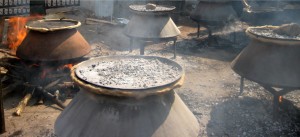Trying to cook biryani in a pressure cooker? You must be still wondering why your biryani is not tasting the best. Well it is your cooking utensil that is stopping you from cooking an authentic Hyderabadi Biryani.
Cooking biryani is not as easy as it sounds in many recipe sites (at least if you want to make it authentic). As you are cooking the meat and the rice together, at a time, it requires lots of attention and patience to makes sure that biryani may not end up with over-cooked rice or under-cooked meat. Also using excess of water in cooking also makes biryani loose its taste as well as the proteins in it.
In order to server all these properties, both the meat and the rice should be cooked evenly on small and spread flame, for a long time. For this, the biryani is prepared in a special utensil called Deg, and more preferably on a wooden stove. You can call it one of the secrets of cooking Hyderabadi biryani.
 The deg is a traditional Indian cookware, a shallow metal pot, generally made of clay, brass, aluminum, copper and even stainless steel. For copper vessels, a small amount of nickeling is done, without which it is poisonous. Its bottom is round, thick and deep. Towards the opening, it linearly tapers into a narrower neck, almost into a conical shape. From the neck, it again flares out into a broad opening, a little smaller in diameter than the largest diameter of the pot. It also has a wide lip/ rim around its top edge to make it easy to carry. Overall it looks like a pot with uncurved walls.
The deg is a traditional Indian cookware, a shallow metal pot, generally made of clay, brass, aluminum, copper and even stainless steel. For copper vessels, a small amount of nickeling is done, without which it is poisonous. Its bottom is round, thick and deep. Towards the opening, it linearly tapers into a narrower neck, almost into a conical shape. From the neck, it again flares out into a broad opening, a little smaller in diameter than the largest diameter of the pot. It also has a wide lip/ rim around its top edge to make it easy to carry. Overall it looks like a pot with uncurved walls.
The bottom is thick to make sure that the meat is not sticking to the base of the vessel, being cooked with little water for a long time. Its design also ensures even distribution of heat from all sides of the bottom and heat retention for longer time without burning the food. The tapered walls heat up faster and distribute it evenly from sides.
After layering meat and rice in the utensil, it is then covered with a lid. The lid is then sealed with a water and flour paste. The flour seal makes sure that the little water, we are cooking with, doesn’t escape the vessel. This method is called Dum-Pukht, borrowed from Awadh cuisine. It is also important to leave around 1/4th of the vessel free after layering the rice and meat, for the steam to collect and aid in cooking.
 Now being cooked on a slow flame, the meat is set to cook well in its own juices, along with the layered rice. When these juices convert into steam, it gets collected in the free space at the opening and then try to escape the vessel. But as the vessel is sealed, the steam condenses and rolls down the sharp slope back in to the food. This cycle keeps continuing till the cooking is done.
Now being cooked on a slow flame, the meat is set to cook well in its own juices, along with the layered rice. When these juices convert into steam, it gets collected in the free space at the opening and then try to escape the vessel. But as the vessel is sealed, the steam condenses and rolls down the sharp slope back in to the food. This cycle keeps continuing till the cooking is done.
Thus, the genuine aroma, flavor and texture of the meat and spices are not only stopped from escaping, it is also spread to the rice in the biryani.
Professional cooks make Biryani on firewood, as it spreads the flame and gives consistent heat on all sides. It is not possible to cook biryani well on a regular gas stove in which flame comes as a torch rather than a spread out flame. When cooking at home or an event where firewood is not possible, look for a stove with the flame that spreads wide.
